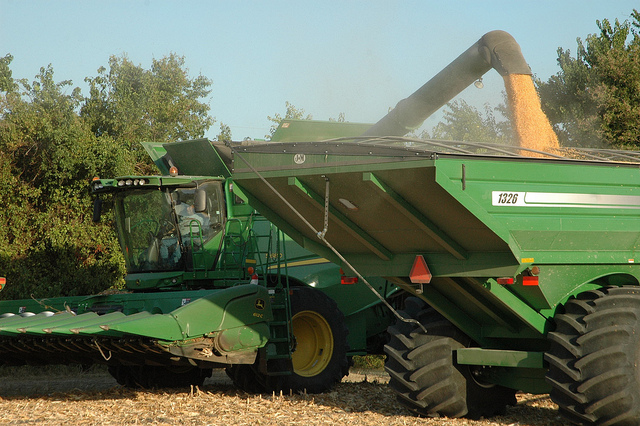Class action status has been granted to corn farmers who filed suit against Syngenta after China rejected 2013 corn shipments containing Viptera and Duracade corn, a Syngenta product approved for use in the US but not for export to China. The first step in the case was for the court to determine whether the farmers could proceed as a class action. Judge Lungstrum says they can. [View order here.]
Background
You may recall that in 2014, corn farmers and various agribusinesses from across the United States filed suit against Syngenta, alleging that producers suffered damages when China rejected corn shipments due to the presence of Viptera and Duracade corn, shortly after which, corn prices fell. Viptera and Duracade, developed and marketed by Syngenta, contain the presence of a genetic trait called MIR-162. Essentially, the lawsuits claim that Syngenta wrongly marketed the product in the US before China had approved imports, causing monetary damages to farmers who did not plant the seeds, as well as grain elevators, shippers, and other businesses. Although cases were filed in various courts across the nation, the cases were consolidated in a multi-district litigation case in the District of Kansas. Plaintiffs’ attorneys claim the losses to be over $5 billion. [Click here for a more detailed fact sheet outlining the plaintiffs’ claims.]
What Is Class Action Certification?
The issue before the court for consideration is whether the farmers’ claims could be certified to proceed as a class action. Last week, the court sided with the farmers, certifying this case as a class action. (The agribusiness plaintiffs have a separate motion pending.)
Class action lawsuits are filed by one or several named plaintiffs on behalf of an entire class of people. The idea behind class actions is that it may be impracticable or uneconomical for numerous plaintiffs with the same complaints against the same defendant to file individual suits. Instead, class actions allow one suit to be filed by one (or several) named plaintiffs on behalf of themselves, and others similarly situated–known as the class. For example, if hundreds of consumers purchased the same defective product and each sued for $1,000, it may be more practical to have one lawsuit on behalf of all of the consumers against the defendant, rather than requiring each of them to come to court separately to seek their judgment.
Certified class action are often involving millions (or even billions) of dollars in damages for the hundreds or thousands of plaintiffs. If, on the other hand, each plaintiff were required to file a separate suit and make their separate monetary claims, each case would seek far less money. And, of course, many plaintiffs would elect not to proceed with the lawsuit if the cost and effort of an individual suit were required.
Court’s Class Certification Analysis
Federal Rule of Civil Procedure 23 governs class action lawsuits.
Under that rule, a plaintiff first must prove that they satisfy the four factors contained in Rule 23(a). Let’s walk through each factor.
Numerosity: Plaintiffs must show that the class is so numerous that joinder of all members in a normal lawsuit is impracticable. This factor was met by evidence that each class would have thousands of members (except the Arkansas class that would have about 600 members).
Commonality: Plaintiffs must show there are common questions of law or fact. Here, there are numerous such common questions including whether Syngenta breached a duty of care, whether their representations were false or misleading, whether they interfered with producers business expectations, whether Syngenta’s actions contributed to the Chinese rejection of corn shipments, and the effect of China’s rejection of corn on the US corn market.
Typicality: All class members must allege the same injury. Here, all producers are claiming lower income due to a depressed corn market after Chinese shipments were rejected.
Adequate Representation: This factor focuses on the ability of the named plaintiffs and their attorneys to adequately represent the class members. Here, the court found that the named plaintiffs’ claims were typical of the class and they had already participated in answering discovery. The attorneys have thus far worked diligently and ably to prosecute class claims.
Next, a plaintiff must satisfy one of the Rule 23(b) factors. Here, the plaintiffs are relying upon 23(b)(3), which requires that common issues of law and fact predominate individual issues and that a class action is the superior method of adjudicating the claims.
Predominance of Common Issues: Here, the court reasoned that all of the class members claim that it was the same conduct by Syngenta that resulted in the same injury to each of them. Syngenta argued that individualized questions regarding damages for each plaintiff should defeat certification, but the court rejected that argument, finding that damage models developed by plaintiffs’ experts appeared to use a common calculation method. Further, Syngenta argued that some farmers–while harmed by lower corn prices when selling corn–actually benefited from the drop in corn prices in other ways, such as increased sorghum prices and lower feed prices for livestock. The court did not address the validity of that argument, but noted instead that any such issues would still be a common issue among many class members, requiring similar proof for each of them.
Superiority of Class Action: This element requires proof that a class action is the superior way to resolve the controversy. Here, the court said it was, particularly given the vast number of plaintiffs and the common issues among them. Requiring separate individual trials for each plaintiff would not be practicable.
Based upon this analysis, the court found the classes should be certified.
Class Definitions
Once the court decided that class certification was proper, it then had to define the classes. The class definition is extremely important, as it determines who is and is not part of the class.
The court’s order certified 9 classes: a nationwide class of all plaintiffs asserting a Lanham Act claim, and statewide classes in Arkansas, Illinois, Iowa, Kansas, Missouri, Nebraska, Ohio, and South Dakota.
For each of the 9 classes, members are corn producers who priced corn for sale after November 18, 2013. For class purposes, a “producer” is a person listed on the USDA FSA Form 578. (Essentially this excludes a cash rent landlord who owns the land but does not share in any risk of production.) Specifically excluded from any of these classes are producers who purchased Viptera or Duracade seeds and certain producers who have filed individual lawsuits seeking recovery for these claims (i.e. Minnesota producers who filed in state court before June 15, 2016 and producers whose attorneys have signed joint prosecution agreements with the class counsel).
A Texas producer, then, would only fall under the nationwide class definition. However, a Kansas producer could fall under both the nationwide class definition as well as the Kansas class definition, and therefore be a member of both classes.
What Happens Next?
Syngenta is reportedly considering appealing the court’s certification ruling. If that appeal is filed, this issue would then make its way through the appellate court system. If certification is upheld on appeal or if Syngenta decides not to appeal the certification ruling, the case would then go back to the trial court for discovery to be conducted, and eventually, a trial on the merits.
Corn farmers who meet the class definitions will likely start receiving notice in the mail in the next couple of months informing them that they are included as a class member in this case, unless they choose to opt-out. Producers who do not opt out will remain in the case and will share proportionately in any settlement or judgment entered, and any order of the court is binding on all class members. Farmers who take the affirmative steps to opt out will neither be bound by any decision (meaning they could bring their own individual lawsuit later), nor will they share in any monetary award. It is extremely important that any producer wishing to opt out of the case in order to pursue an individual action seek advice from an attorney about the availability of such actions immediately, as issues such as statutes of limitations may come into play.












